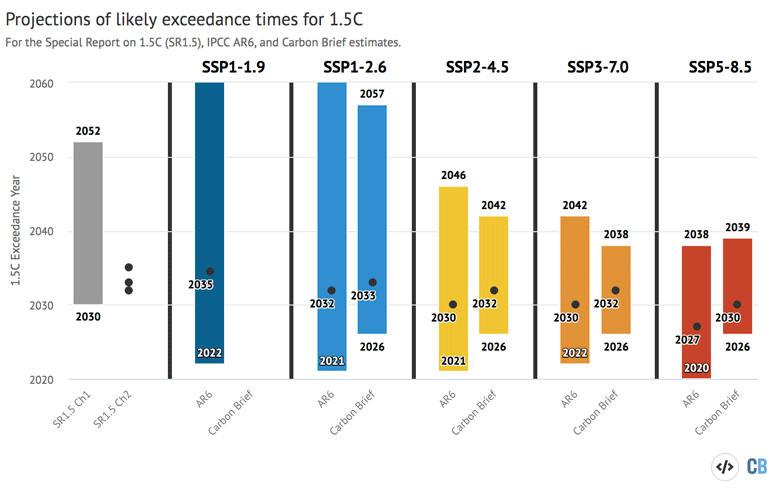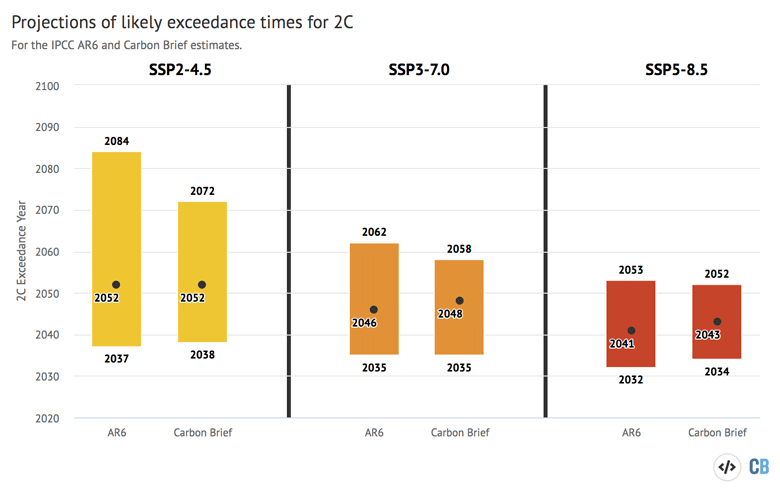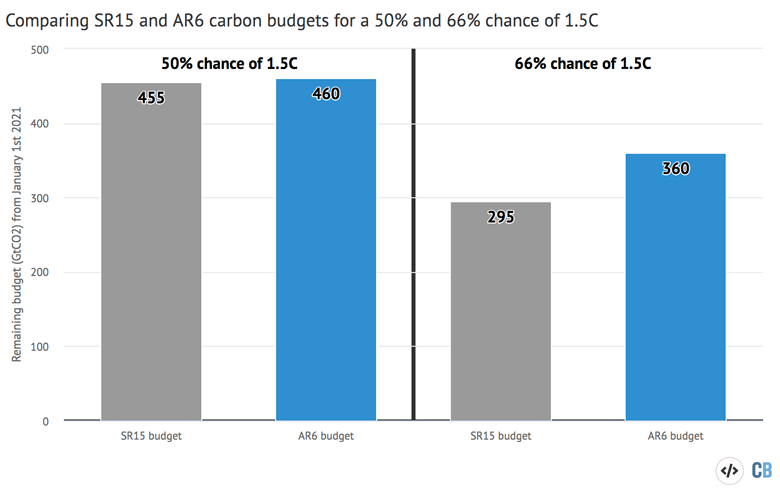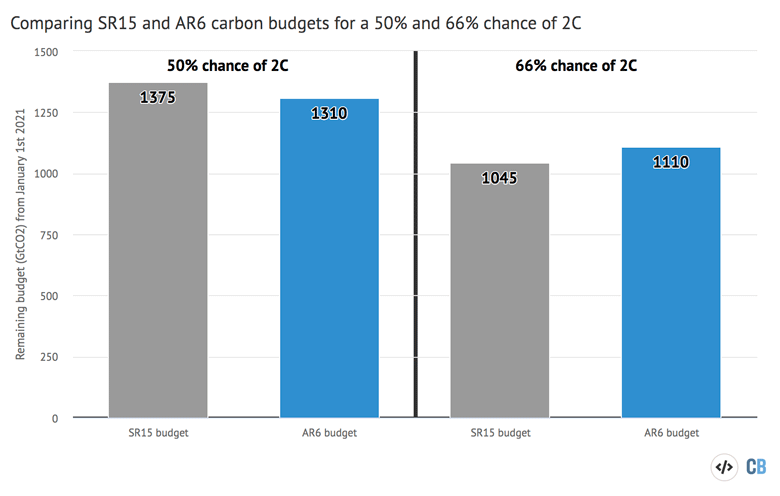
Analysis: What the new IPCC report says about when world may pass 1.5C and 2C
Zeke Hausfather
08.10.21Zeke Hausfather
10.08.2021 | 5:53pmThe Intergovernmental Panel on Climate Change’s (IPCC) sixth assessment report (AR6) is the first major IPCC review to specifically focus on when the world might pass the 1.5C and 2C warming levels.
AR6 uses a combination of historical observations, climate models and an updated estimate of climate sensitivity to provide a best-estimate that the world will pass – or temporarily “reach” – 1.5C somewhere between 2030 and 2035, depending on the future emissions scenario.
-
WG1
- In-depth Q&A: The IPCC’s sixth assessment report on climate science
- Scientists react: What are the key new insights from the IPCC’s WG1 report? WG2
- In-depth Q&A: The IPCC’s sixth assessment on how climate change impacts the world
- Scientists react: What are the key new insights from the IPCC’s WG2 report? WG3
- In-depth Q&A: The IPCC’s sixth assessment on how to tackle climate change
- Scientists react: What are the key new insights from the IPCC’s WG3 report?
Even in the most stringent mitigation scenario examined in the report – SSP1-1.9 – the world exceeds 1.5C in most models during the middle of the 21st century, before falling back down below 1.5C by 2100 due to the large-scale deployment of negative emissions technologies (for more details on the Shared Socioeconomic Pathways (SSPs) used in the AR6, read Carbon Brief’s explainer).
The date that the world is expected to pass 1.5C is in “the early part of the range” suggested in Chapter 1 of the IPCC’s 2018 special report on 1.5C (SR15), due to a combination of revisions to historical temperature records and higher near-term warming projections. However, a separate, more directly comparable estimate found in Chapter 2 of the SR15 report is nearly identical to the new AR6 estimates.
The world is expected to pass 2C in emissions scenarios that do not feature strong near-term mitigation with a best-estimate of between the early 2040s and the early 2050s. These – and the 1.5C exceedance dates – are quite similar to those given in an earlier Carbon Brief analysis published in late 2020.
AR6 has also updated the remaining “carbon budget” that can be emitted before the world is committed to 1.5C or 2C of warming.
The carbon budget for a 50% chance to limit warming to 1.5C is quite similar to that given in the SR15 report. It shows that the world can emit around 460bn tonnes of CO2 (GtCO2) – or just 11.5 years of current (2020) emissions – after 1 January 2021 before being committed to 1.5C.
The carbon budgets for limiting warming to 1.5C with a 66% chance has been slightly increased due to the narrower range of climate sensitivity in the AR6. The remaining carbon budget to limit warming to 2C is similarly affected.
In addition, the report introduces new carbon budgets for limiting warming to 1.7C, as well as for limiting to each temperature with higher (83%) or lower (17%) probability.
The narrower range of future projected warming in the AR6 compared to past IPCC reports – coupled with more historical observations over the past few years – provides a better sense of when these important warming levels may be exceeded.
When will the world pass 1.5C?
AR6 focuses in some depth on when the world might pass 1.5C and 2C warming levels relative to the pre-industrial period. The authors suggest that the world is likely to pass 1.5C in the early 2030s, in the absence of rapid emissions mitigation. This is in the earliest part of the 2030-52 range reported in the SR15 summary for policymakers (SPM).
-
WG1
- Media reaction: IPCC’s new climate science report and what it means for the world
- Analysis: What the new IPCC report says about when world may pass 1.5C and 2C
- Explainer: What the new IPCC report says about extreme weather and climate change
- IPCC: How the AR6 WG1 summary for policymakers compares to its predecessor WG3
- Analysis: What the new IPCC report says about how to limit warming to 1.5C or 2C
- Guest post: How not to interpret the emissions scenarios in the IPCC report
- Guest post: Why estimates of the ‘cost’ of climate action are overly pessimistic
The 1.5C and 2C warming levels are noteworthy in part because they reflect the targets set in the Paris Agreement. However, Paris targets specifically refer to end-of-century warming outcomes, so scenarios such as SSP1-1.9 – which overshoot 1.5C mid-century before reducing temperatures back down through a large-scale deployment of negative emissions – are nominally consistent with Paris goals, even if they may exceed 1.5C during the 21st century.
(See Carbon Brief’s Q&A on the IPCC report for an introduction to the scenarios used by the IPCC, or Carbon Brief’s explainer for more details.)
Calculating when the world exceeds a particular temperature threshold is not a straightforward exercise. Global average surface temperatures in any given year are driven by a combination of long-term warming and short-term natural variability. The latter – driven by El Niño and La Niña events or volcanic eruptions – can result in a year being up to 0.2C warmer or cooler than the trajectory of long-term human-caused warming. This means it is quite possible for humans to have only warmed the world by 1.3C – only slightly above today’s level – and see a single year that exceeds 1.5C. In fact, the World Meteorological Organization estimated last year that there is a one-in-four chance that the world will exceed 1.5C for at least one year by 2025.
The international community of researchers and policymakers is more concerned with the effects of long-term human-caused warming than short-term natural variability. Because of this, passing the 1.5C and 2C limits has generally been defined based on a multi-year average rather than a single year, though there is no clear agreed-upon approach.
To avoid the problem of over-interpreting short-term variability, the AR6 authors calculate the 20-year periods where the average temperature reaches 1.5C (or 2C) warming above pre-industrial levels.
For example, in the SSP2-4.5 scenario, they find that 2021-40 is the first 20-year period when the average is most likely to exceed 1.5C. This formulation is a bit confusing – in order to simplify it (and compare it to other approaches) Carbon Brief uses the mid-point of the 20-year period (for example, 2030 in the case of a 2021-40) as the likely point at which the longer-term average temperature exceeds 1.5C, following the approach used in Chapter 4 of the AR6. This generally provides a good estimate of the likely exceedance year, though may be slightly off in cases where the rate of warming changes significantly over the course of the 20-year period (for example, in very high emissions scenarios).
Both the SR15 report and a 2020 analysis by Carbon Brief used a somewhat different approach; rather than looking at 20-year averages, these methods smoothed the data to remove short-term temperature variability before calculating the likely exceedance year. Carbon Brief used the new CMIP6 models, while the SR15 Chapter 1 assessment simply extrapolated historical warming trends and uncertainties into the future. AR6, on the other hand, uses its own assessed warming range based on CMIP6 models constrained by both observations and climate sensitivity estimates.
The SR15 report actually included two separate assessments of when the world might pass 1.5C. Chapter 1 of the report suggested that the world would pass 1.5C somewhere between 2030 and 2052, adding that there was stronger evidence to support the early part of this range.
The Chapter 1 text did not give a central estimate, but did include a figure, showing the world passing 1.5C around 2040. This was based on an assumed continuation of the (at the time) historical warming trend of 0.2C per decade.
However, this value underestimates both recent observed warming trends (in part due to corrections to observational temperature records in the years since the publication of the SR15) and is lower than the near-term warming projections in most of scenarios evaluated in the SR15 report (and those in the new AR6).
In addition, deep in the supplementary materials of Chapter 2 of the SR15 report was an estimate (in Table 2. SM.12) that a 1.5C low overshoot scenario (similar to the SSP1-1.9 scenarios) would pass 1.5C around 2035. It suggested that well-below 2C scenarios (similar to SSP2-2.6) would pass 1.5C around 2033. These values are nearly identical to the best estimates in the new IPCC report, though because they were not highlighted in the main text, this was not widely understood at the time.
The figure below shows the main SR15 projection of 1.5C exceedance times (grey bar), along with the new AR6 likely exceedance year (and uncertainty ranges) for each of the new SSP scenarios. In addition, Carbon Brief’s estimates of when the world might pass 1.5C are shown alongside the new IPCC projections for comparison purposes.

The new AR6 values are notably in the earliest part of the range given by SR15 Chapter 1. The AR6 estimates that the world will pass 1.5C around 2030 under a moderate emissions scenario (SSP2-4.5), whereas SR15 gave a range of 2030-52.
However, as mentioned above, the AR6 numbers are in line with those in the SR15 Chapter 2 supplementary materials. More broadly, the AR6 finds a best-estimate exceedance year of 2027-35 across all of the models examined, albeit with a wide uncertainty range for each. In scenarios without rapid mitigation, the world is very likely to exceed 1.5C in the late 2030s (SSP5-8.5) or mid-2040s (SSP2-4.5) at the latest.
The new AR6 central estimates of when the world will likely pass 1.5C are generally quite similar to Carbon Brief’s 2020 analysis, though are, on balance, a few years earlier. More importantly, the uncertainty range in the AR6 is considerably larger, suggesting that the long-term average temperature may pass 1.5C as early as 2020 or 2021.
However, passing 1.5C this early is a very unlikely outcome given observed temperatures today. These early potential exceedance dates are likely something of an artifact of model-observation mismatches after the 1995-2014 normalisation periods – where models and observations are matched in the AR6. Carbon Brief’s earlier analysis, by contrast, used model projections from 2020 onwards based on a best-estimate of the human contribution to warming.
Crossing 2C
In addition to 1.5C exceedance years, the AR6 report provides estimates of when the world may pass 2C warming relative to pre-industrial levels. These are shown for each SSP scenario expected to pass 2C in the figure below, alongside Carbon Brief’s own estimates. Note that SSP1-1.9 and SSP2-2.6 are excluded as temperatures are unlikely to exceed 2C in most models under these scenarios.

AR6 finds that in the modest-mitigation SSP2-4.5 scenario the world is likely to exceed 2C around 2052, with a range of 2037 to 2084. For the high emissions SSP3-7.0 scenario, the world is likely to pass 2C around 2046 (with a range of 2035-2062), while in the very high emissions SSP5-8.5 scenario it is 2041 (with a range of 2032 to 2053).
These values are effectively identical to Carbon Brief’s earlier estimates, except for a wider range of possible later exceedance dates in SSP2-4.5 and SSP3-7.0. This may reflect differences between the unweighted CMIP6 models used by Carbon Brief and the assessed warming range in the AR6.
The results of the new AR6 report are clear: the best estimate is that the world will pass 1.5C in the 2030s, even under the rapid mitigation scenarios of SSP1-1.9 and SSP1-2.6. However, there is still a chance in these scenarios that the world will not pass 1.5C, particularly under the SSP1-1.9 scenario and if sensitivity of the climate to CO2 and other greenhouse gas emissions is on the low end of the range assessed in the AR6 report.
In the SSP1-1.9 scenario, the best estimate is that the world will overshoot 1.5C in the middle of the 21st century – warming by 1.6C relative to pre-industrial levels – before temperatures fall back down to below 1.5C by 2100 through the widespread use of negative emissions technologies.
The world is unlikely to warm more than 2C in either of the deep mitigation scenarios. In the other three scenarios examined, however, the best estimate is that the world will pass 2C somewhere between the early 2040s and early 2050s.
Updates to the remaining carbon budget
The year in which the world will exceed 1.5C and 2C warming levels is a related, but somewhat separate, question from the remaining carbon budget.
Carbon budgets are a simplified way to measure the maximum emissions that can still enter the atmosphere if the world wishes to limit global warming to levels such as 1.5C. They are based on the fact that the amount of warming that will occur can be approximated by total – that is, cumulative – CO2 emissions.
In practice, though, carbon budgets mask a lot of complexity. Because the world is already most of the way to 1.5C of warming, the remaining budget is relatively small and, therefore, quite sensitive to the approach used. The 2018 SR15 report significantly expanded the carbon budget, relative to what was reported in the IPCC fifth assessment report (AR5) in 2013-14. This was primarily due to the use of observations rather than climate model projections to estimate historical warming; for more technical details see this Carbon Brief analysis.
AR6 used a broadly similar approach to that of the SR15 (Chapter 2) to calculate the remaining budget and generally obtained similar results. The figure below shows the remaining carbon budgets for both a 50% chance and a 66% chance of avoiding more than 1.5C warming above pre-industrial levels from the SR15 and the AR6, as of 1 January 2021.
These are calculated by subtracting observed global emissions (as reported by the Global Carbon Project) over the 2018-20 period from the SR15 budget (which gives the remaining allowable budget starting in 2018) and by subtracting observed 2020 emissions from the AR6 budget (which provides a budget starting in 2020).

Both the SR15 and AR6 suggest that the world has around 460GtCO2 remaining in the 1.5C budget for a 50% avoidance chance. This means that the remaining carbon budget would be fully exhausted in just 11.5 years of current (2020) emissions – and less than that if global emissions rebound (as expected) in 2021 and do not decrease over the next decade. For example, the carbon budget would be used up in 10.7 years if emissions continued at 2019 levels. This would result in a world committed to a 1.5C temperature increase around 2031 – quite similar to the best estimate exceedance dates found in the AR6 discussed above.
For a 66% chance of limiting warming to 1.5C, AR6 reports that the world has a remaining carbon budget of 360GtCO2 – or nine years of current emissions.
This is a notable increase from the SR15 carbon budget of 295GtCO2. This increased carbon budget for a 66% avoidance chance reflects a narrower transient climate response to cumulative carbon emissions (TCRE) value calculated in the AR6 report (1C to 2.3C per 1000 gigatons of carbon – GtC) than in the SR15 (0.8C to 2.5C per 1,000GtC), resulting from the narrower estimate of climate sensitivity in the AR6. This TCRE revision does not affect the 50% avoidance chance as the best-estimate of TCRE is unchanged at 1.65C per 1,000GtC.
Carbon budgets tell us how much CO2 we can still emit while keeping warming below specific limits.
— Joeri Rogelj (@JoeriRogelj) August 9, 2021
The latest @IPCC_CH report provides updated estimates of these budgets.
Here’s an insider’s view with a deep dive looking at how they have changed since previous reports. (1/n) pic.twitter.com/7G7Era6uVa
Methodological changes
A number of other important elements were updated in the AR6 carbon budget calculations.
First, updated temperature records were used that moved the world a bit closer to 1.5C than was assumed in the SR15 report, which, all things being equal, would result in a lower carbon budget. However, in the SR15 report the global surface air temperature (GSAT) was assumed to be warming faster than the global mean surface temperature (GMST), resulting in a smaller carbon budget.
(GMST is the standard metric used when discussing historical, observation-based recordings. It is based on a combination of land-surface air temperatures from weather stations and the sea surface temperature, measured using buoys and ships. It is subtly different from GSAT, which is generally used by climate models. It is also based on land surface air temperatures, but this is combined with temperatures of the air above seawater, rather than of the seawater itself.)
AR6 – based on more recent studies – found more limited evidence for this assumption, and did not assume any difference between GSAT and GMST. This change largely counterbalanced the reduction in the carbon budget associated with updated temperature records, resulting in a 50% avoidance budget nearly identical to that of the SR15.
The SR15 report suggested that unrepresented Earth system feedbacks – such as thawing permafrost – could result in a reduction of remaining carbon budgets of up to 100GtCO2 over the course of this century – and these were not included in the remaining carbon budgets numbers. The AR6 lowers this estimate of Earth system feedbacks to 26GtCO2 per degree C warming (albeit with an uncertainty of ±97GtCO2) and includes these feedbacks in its carbon budget numbers – while acknowledging that there is still low confidence in the exact magnitude of these estimates.
Carbon budget for 2C
In addition to remaining carbon budgets for 1.5C, both the SR15 and AR6 provide carbon budgets for 2C. These are shown – calculated as starting in 2021 – in the figure below.

AR6 slightly reduces the remaining carbon budget for a 50% chance of avoiding 2C, relative to that in the SR15 – from 1,375GtCO2 (or 34 years of current emissions) to 1,310GtCO2 (or 33 years of current emissions). This suggests that the world will exhaust its remaining 2C carbon budget around 2053 if current emissions continue – quite similar to the 2052 exceedance year in the modest mitigation SSP2-4.5 scenario discussed earlier.
For a 66% chance of avoiding 2C warming – which is how the Paris Agreement goal of limiting warming to well-below 2C is commonly interpreted – AR6 has slightly increased the remaining carbon budget from 1,045GtCO2 (26 years of current emissions) to 1,110GtCO2 (28 years of current emissions). This reflects the updated TCRE values in the AR6 compared to the SR15 report.
Overall, both the exceedance years and carbon budgets reported in the AR6 are similar to values reported in the SR15 report – despite notable updates to the models used for calculating exceedance years and the approach used for calculating carbon budgets. The AR6 exceedance estimate of around 2030 is in the earliest part of the range reported by Chapter 1 of SR15 but is very similar to the values reported in the supplementary materials of the SR15.
-
Analysis: What the new IPCC report says about when world may pass 1.5C and 2C

